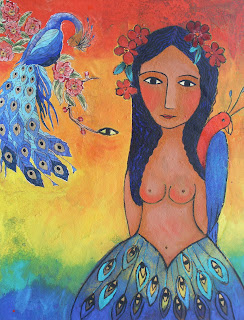


Both Raw Vision magazine and Wikipedia have posted this information before, but I offer it again as a good starting point for understanding the difference between many of the terms used to define outsider art.
A number of terms are used to describe art that is loosely understood as "outside" of official culture. Definitions of these terms vary, and there are areas of overlap between them. The editors of Raw Vision, a leading journal in the field, suggest that "Whatever views we have about the value of controversy itself, it is important to sustain creative discussion by way of an agreed vocabulary". Consequently they lament the use of "outsider artist" to refer to almost any untrained artist. "It is not enough to be untrained, clumsy or naïve. Outsider Art is virtually synonymous with Art Brut in both spirit and meaning, to that rarity of art produced by those who do not know its name."
- Art Brut: literally translated from French means "raw art"; 'Raw' in that it has not been through the 'cooking' process: the art world of art schools, galleries, museums. Originally art by psychotic individuals who existed almost completely outside culture and society. Strictly speaking it refers only to the Collection de l'Art Brut.
- Folk art: Folk art originally suggested crafts and decorative skills associated with peasant communities in Europe - though presumably it could equally apply to any indigenous culture. It has broadened to include any product of practical craftsmanship and decorative skill - everything from chain-saw animals to hub-cap buildings. A key distinction between folk and outsider art is that folk art typically embodies traditional forms and social values, where outsider art stands in some marginal relationship to society's mainstream.
- Intuitive art / Visionary art: Raw Vision Magazine's preferred general terms for outsider art. It describes them as deliberate umbrella terms. However, Visionary Art unlike other definitions here can often refer to the subject matter of the works, which includes images of a spiritual or religious nature. Intuitive art is probably the most general term available. Intuit: The Center for Intuitive and Outsider Art based in Chicago operates a museum dedicated to the study and exhibition of intuitive and outsider art. The American Visionary Art Museum in Baltimore, Maryland is dedicated to the collection and display of visionary art.
- Marginal art/Art singulier: Essentially the same as Neue Invention; refers to artists on the margins of the art world.
- Naïve art: Another term commonly applied to untrained artists who aspire to "normal" artistic status, i.e. they have a much more conscious interaction with the mainstream art world than do outsider artists.
- Neuve Invention: Used to describe artists who, although marginal, have some interaction with mainstream culture. They may be doing art part-time for instance. The expression was coined by Dubuffet too; strictly speaking it refers only to a special part of the Collection de l'Art Brut.
- Visionary environments: Buildings and sculpture parks built by visionary artists - range from decorated houses, to large areas incorporating a large number of individual sculptures with a tightly associated theme. Examples include Watts Towers by Simon Rodia, Buddha Park and Sala Keoku by Bunleua Sulilat, and The Palais Ideal by Ferdinand Cheval.















































